写在前面
- 学习并理解基于Python的Mininet脚本。
- 核心:通过“ovs-vsctl”命令,给OvS交换机下流表。
实验简介
在SDN环境中,控制器可以通过对交换机下发流表操作来控制交换机的转发行为。在本实验中,使用Mininet基于python的脚本,调用“ovs-vsctl”命令直接控制OpenvSwitch。使用默认的交换机泛洪规则,设置更高的优先级规则进行预先定义IP报文的转发。在多个交换机中通过设置不同TOS值的数据包将通过不同的方式到达目的地址,验证主机间的连通性及到达目的的时间。
实验任务一
使用默认的交换机泛洪规则,设置更高的优先级规则进行预先定义IP报文的转发。
- 实验一拓扑
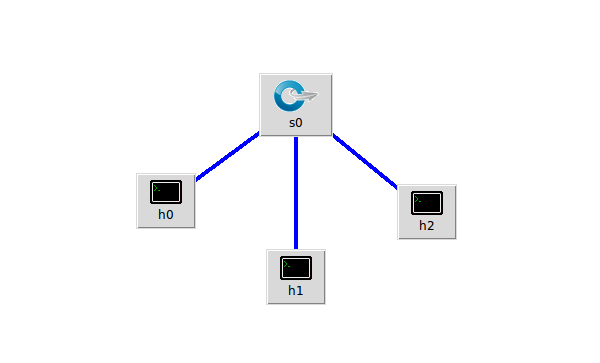
- 创建脚本,并编辑内容如下:
#!/usr/bin/python
from mininet.net import Mininet
from mininet.node import Node
from mininet.link import Link
from mininet.log import setLogLevel, info
def myNet():
"Create network from scratch using Open vSwitch."
info( "*** Creating nodes
" ) #创建节点
switch0 = Node( 's0', inNamespace=False )
h0 = Node( 'h0' )
h1 = Node( 'h1' )
h2 = Node( 'h2' )
info( "*** Creating links
" ) #创建连接
Link( h0, switch0)
Link( h1, switch0)
Link( h2, switch0)
info( "*** Configuring hosts
" )
h0.setIP( '192.168.123.1/24' )
h1.setIP( '192.168.123.2/24' )
h2.setIP( '192.168.123.3/24' )
info( "*** Starting network using Open vSwitch
" )
switch0.cmd( 'ovs-vsctl del-br dp0' )
switch0.cmd( 'ovs-vsctl add-br dp0' )
for intf in switch0.intfs.values(): #为刚刚创建的连接,依次分配端口
print intf
print switch0.cmd( 'ovs-vsctl add-port dp0 %s' % intf )
# Note: controller and switch are in root namespace, and we
# can connect via loopback interface
#switch0.cmd( 'ovs-vsctl set-controller dp0 tcp:127.0.0.1:6633' )
print switch0.cmd(r'ovs-vsctl show')
#下发流表
print switch0.cmd(r'ovs-ofctl add-flow dp0 idle_timeout=0,priority=1,in_port=1,actions=flood' )
print switch0.cmd(r'ovs-ofctl add-flow dp0 idle_timeout=0,priority=1,in_port=2,actions=flood' )
print switch0.cmd(r'ovs-ofctl add-flow dp0 idle_timeout=0,priority=1,in_port=3,actions=flood' )
print switch0.cmd(r'ovs-ofctl add-flow dp0 idle_timeout=0,priority=10,ip,nw_dst=192.168.123.1,actions=output:1' )
print switch0.cmd(r'ovs-ofctl add-flow dp0 idle_timeout=0,priority=10,ip,nw_dst=192.168.123.2,actions=output:2' )
print switch0.cmd(r'ovs-ofctl add-flow dp0 idle_timeout=0,priority=10,ip,nw_dst=192.168.123.3,actions=output:3')
#switch0.cmd('tcpdump -i s0-eth0 -U -w aaa &')
#h0.cmd('tcpdump -i h0-eth0 -U -w aaa &')
info( "*** Running test
" )
h0.cmdPrint( 'ping -c 3 ' + h1.IP() )
h0.cmdPrint( 'ping -c 3 ' + h2.IP() )
#print switch0.cmd( 'ovs-ofctl show dp0' )
#print switch0.cmd( 'ovs-ofctl dump-tables dp0' )
#print switch0.cmd( 'ovs-ofctl dump-ports dp0' )
#print switch0.cmd( 'ovs-ofctl dump-flows dp0' )
#print switch0.cmd( 'ovs-ofctl dump-aggregate dp0' )
#print switch0.cmd( 'ovs-ofctl queue-stats dp0' )
info( "*** Stopping network
" )
switch0.cmd( 'ovs-vsctl del-br dp0' )
switch0.deleteIntfs()
info( '
' )
if __name__ == '__main__':
setLogLevel( 'info' )
info( '*** Scratch network demo (kernel datapath)
' )
Mininet.init()
myNet()
s0中的流表项:
- 优先级为10:
- 目的IP为192.168.123.1(h0)的包,1口发出。
- 目的IP为192.168.123.2(h1)的包,2口发出。
- 目的IP为192.168.123.3(h2)的包,3口发出。
- 优先级为1:
- 1口进来的包,泛洪发出。
- 2口进来的包,泛洪发出。
- 3口进来的包,泛洪发出。
- 给权限后运行脚本。
- 结果如下:
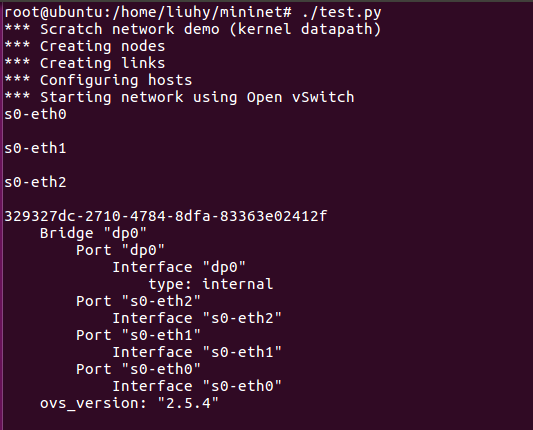
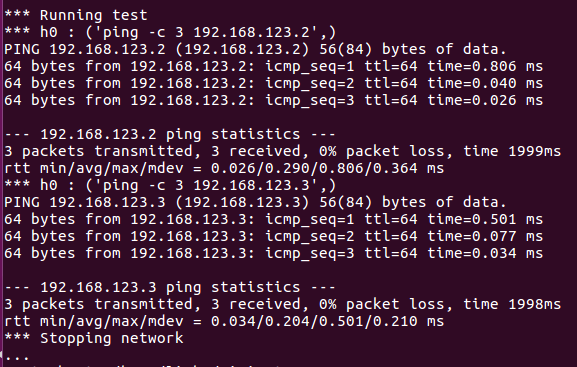
实验任务二
在多个交换机中通过设置不同TOS值的数据包将通过不同的方式到达目的地址,验证主机间的连通性及到达目的的时间。
- 实验二拓扑:
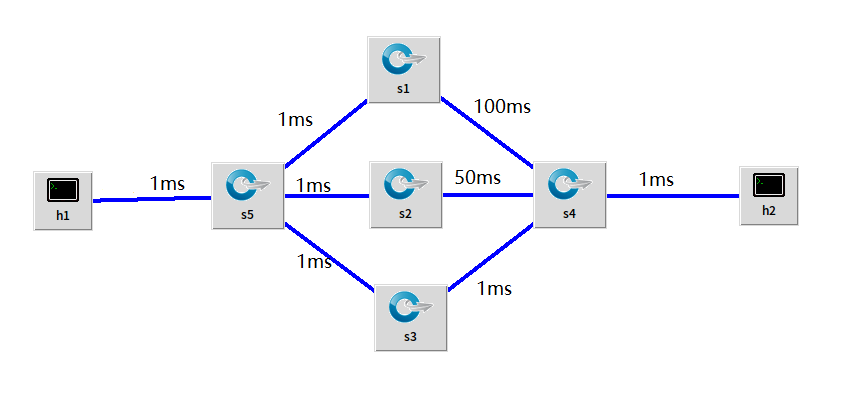
TOS值:
RFC 791中定义了TOS位的前三位为IP Precedence,划分成了8个优先级,即:IP优先级字段。可以应用于流分类,数值越大表示优先级越高。IP 优先权与CoS 相同,有8种服务(0 到7)可以标记。IP优先权值应用类型如下:
- 7 预留(Reserved)
- 6 预留(Reserved)
- 5 语音(Voice)
- 4 视频会议(Video Conference)
- 3 呼叫信号(Call Signaling)
- 2 高优先级数据(High-priority Data)
- 1 中优先级数据(Medium-priority Data)
- 0 尽力服务数据(Best-effort Data)
在网络中实际部署的时候8个优先级是远远不够的,于是在RFC 2474中又对TOS进行了重新的定义。把前六位定义成DSCP差分服务代码点(Differentiated Services Code Point),后两位保留。
- 建立脚本并修改为以下内容:
#!/usr/bin/python
from mininet.net import Mininet
from mininet.node import Node
from mininet.link import TCLink
from mininet.log import setLogLevel, info
def myNet():
"Create network from scratch using Open vSwitch."
info( "*** Creating nodes
" )
switch0 = Node( 's0', inNamespace=False )
switch1 = Node( 's1', inNamespace=False )
switch2 = Node( 's2', inNamespace=False )
switch3 = Node( 's3', inNamespace=False )
switch4 = Node( 's4', inNamespace=False )
h0 = Node( 'h0' )
h1 = Node( 'h1' )
info( "*** Creating links
" )
linkopts0=dict(bw=100, delay='1ms', loss=0)
linkopts1=dict(bw=1, delay='100ms', loss=0)
linkopts2=dict(bw=10, delay='50ms', loss=0)
linkopts3=dict(bw=100, delay='1ms', loss=0)
TCLink( h0, switch0, **linkopts0)
TCLink( switch0, switch1, **linkopts0)
TCLink( switch0, switch2, **linkopts0)
TCLink( switch0, switch3, **linkopts0)
TCLink( switch1, switch4,**linkopts1)
TCLink( switch2, switch4,**linkopts2)
TCLink( switch3, switch4,**linkopts3)
TCLink( h1, switch4, **linkopts0)
info( "*** Configuring hosts
" )
h0.setIP( '192.168.123.1/24' )
h1.setIP( '192.168.123.2/24' )
info( str( h0 ) + '
' )
info( str( h1 ) + '
' )
info( "*** Starting network using Open vSwitch
" )
switch0.cmd( 'ovs-vsctl del-br dp0' )
switch0.cmd( 'ovs-vsctl add-br dp0' )
switch1.cmd( 'ovs-vsctl del-br dp1' )
switch1.cmd( 'ovs-vsctl add-br dp1' )
switch2.cmd( 'ovs-vsctl del-br dp2' )
switch2.cmd( 'ovs-vsctl add-br dp2' )
switch3.cmd( 'ovs-vsctl del-br dp3' )
switch3.cmd( 'ovs-vsctl add-br dp3' )
switch4.cmd( 'ovs-vsctl del-br dp4' )
switch4.cmd( 'ovs-vsctl add-br dp4' )
for intf in switch0.intfs.values():
print intf
print switch0.cmd( 'ovs-vsctl add-port dp0 %s' % intf )
for intf in switch1.intfs.values():
print intf
print switch1.cmd( 'ovs-vsctl add-port dp1 %s' % intf )
for intf in switch2.intfs.values():
print intf
print switch2.cmd( 'ovs-vsctl add-port dp2 %s' % intf )
for intf in switch3.intfs.values():
print intf
print switch3.cmd( 'ovs-vsctl add-port dp3 %s' % intf )
for intf in switch4.intfs.values():
print intf
print switch4.cmd( 'ovs-vsctl add-port dp4 %s' % intf )
print switch1.cmd(r'ovs-ofctl add-flow dp1 idle_timeout=0,priority=1,in_port=1,actions=flood' )
print switch1.cmd(r'ovs-ofctl add-flow dp1 idle_timeout=0,priority=1,in_port=1,actions=output:2' )
print switch1.cmd(r'ovs-ofctl add-flow dp1 idle_timeout=0,priority=1,in_port=2,actions=output:1' )
print switch2.cmd(r'ovs-ofctl add-flow dp2 idle_timeout=0,priority=1,in_port=1,actions=output:2' )
print switch2.cmd(r'ovs-ofctl add-flow dp2 idle_timeout=0,priority=1,in_port=2,actions=output:1' )
print switch3.cmd(r'ovs-ofctl add-flow dp3 idle_timeout=0,priority=1,in_port=1,actions=output:2' )
print switch3.cmd(r'ovs-ofctl add-flow dp3 idle_timeout=0,priority=1,in_port=2,actions=output:1' )
print switch4.cmd(r'ovs-ofctl add-flow dp4 idle_timeout=0,priority=1,in_port=1,actions=output:4' )
print switch4.cmd(r'ovs-ofctl add-flow dp4 idle_timeout=0,priority=1,in_port=2,actions=output:4' )
print switch4.cmd(r'ovs-ofctl add-flow dp4 idle_timeout=0,priority=1,in_port=3,actions=output:4' )
print switch4.cmd(r'ovs-ofctl add-flow dp4 idle_timeout=0,priority=1,in_port=4,actions=output:3' )
#print switch0.cmd(r'ovs-ofctl add-flow dp0 idle_timeout=0,priority=10,ip,nw_dst=192.168.123.2,actions=output:4')
print switch0.cmd(r'ovs-ofctl add-flow dp0 idle_timeout=0,priority=10,ip,nw_dst=192.168.123.2,nw_tos=0x10,actions=output:2')
print switch0.cmd(r'ovs-ofctl add-flow dp0 idle_timeout=0,priority=10,ip,nw_dst=192.168.123.2,nw_tos=0x20,actions=output:3')
print switch0.cmd(r'ovs-ofctl add-flow dp0 idle_timeout=0,priority=10,ip,nw_dst=192.168.123.2,nw_tos=0x30,actions=output:4')
#print switch0.cmd(r'ovs-ofctl add-flow dp0 idle_timeout=0,priority=10,ip,nw_dst=192.168.123.1,actions=output:1')
#switch0.cmd('tcpdump -i s0-eth0 -U -w aaa &')
#h0.cmd('tcpdump -i h0-eth0 -U -w aaa &')
info( "*** Running test
" )
h0.cmdPrint( 'ping -Q 0x10 -c 3 ' + h1.IP() )
h0.cmdPrint( 'ping -Q 0x20 -c 3 ' + h1.IP() )
h0.cmdPrint( 'ping -Q 0x30 -c 3 ' + h1.IP() )
#h1.cmdPrint('iperf -s -p 12345 -u &')
#h0.cmdPrint('iperf -c ' + h1.IP() +' -u -b 10m -p 12345 -t 10 -i 1')
#print switch0.cmd( 'ovs-ofctl show dp0' )
#print switch1.cmd( 'ovs-ofctl show dp1' )
#print switch2.cmd( 'ovs-ofctl show dp2' )
#print switch3.cmd( 'ovs-ofctl show dp3' )
#print switch4.cmd( 'ovs-ofctl show dp4' )
#print switch0.cmd( 'ovs-ofctl dump-tables dp0' )
#print switch0.cmd( 'ovs-ofctl dump-ports dp0' )
#print switch0.cmd( 'ovs-ofctl dump-flows dp0' )
#print switch0.cmd( 'ovs-ofctl dump-aggregate dp0' )
#print switch0.cmd( 'ovs-ofctl queue-stats dp0' )
#print "Testing video transmission between h1 and h2"
#h1.cmd('./myrtg_svc -u > myrd &')
#h0.cmd('./mystg_svc -trace st 192.168.123.2')
info( "*** Stopping network
" )
switch0.cmd( 'ovs-vsctl del-br dp0' )
switch0.deleteIntfs()
switch1.cmd( 'ovs-vsctl del-br dp1' )
switch1.deleteIntfs()
switch2.cmd( 'ovs-vsctl del-br dp2' )
switch2.deleteIntfs()
switch3.cmd( 'ovs-vsctl del-br dp3' )
switch3.deleteIntfs()
switch4.cmd( 'ovs-vsctl del-br dp4' )
switch4.deleteIntfs()
info( '
' )
if __name__ == '__main__':
setLogLevel( 'info' )
info( '*** Scratch network demo (kernel datapath)
' )
Mininet.init()
myNet()
s0中的流表项:
- 优先级为10:
- 目的IP为192.168.123.2(h1)的包且TOS为10,2口发出。
- 目的IP为192.168.123.2(h1)的包且TOS为20,3口发出。
- 目的IP为192.168.123.2(h1)的包且TOS为30,4口发出。
s1中的流表项:
- 优先级为1:
- 1口进来的包,泛洪发出。
- 1口进来的包,2口发出。
- 2口进来的包,1口发出。
s2中的流表项:
- 优先级为1:
- 1口进来的包,2口发出。
- 2口进来的包,1口发出。
s3中的流表项:
- 优先级为1:
- 1口进来的包,2口发出。
- 2口进来的包,1口发出。
s4中的流表项:
- 优先级为1:
- 1口进来的包,4口发出。
- 2口进来的包,4口发出。
- 3口进来的包,4口发出。
- 4口进来的包,3口发出。
本实验中设置了链路的带宽以及时延,可以通过ping的时间来区分转发的路径。
- 效果截图:
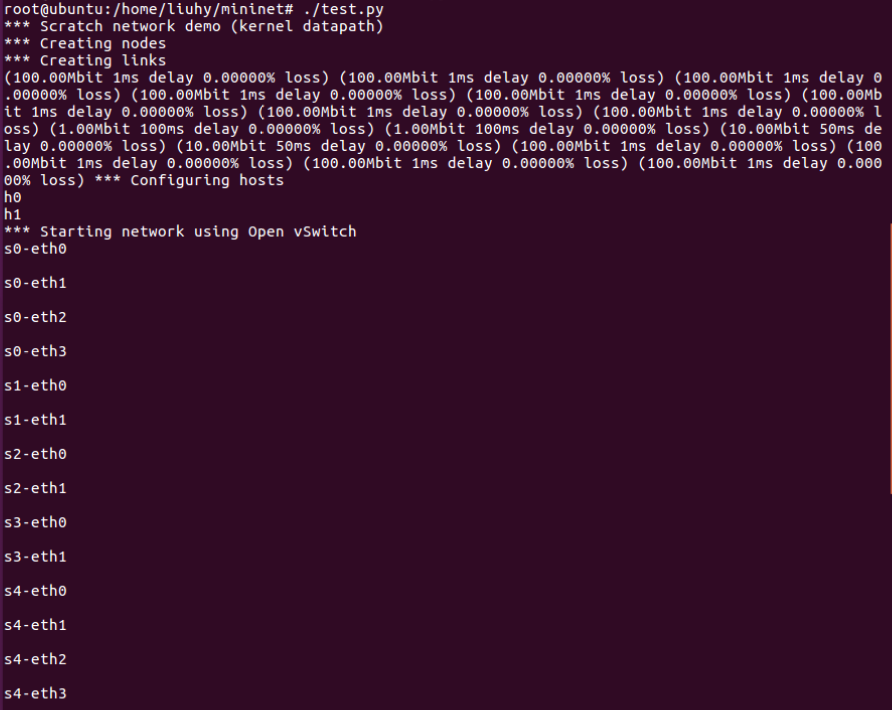
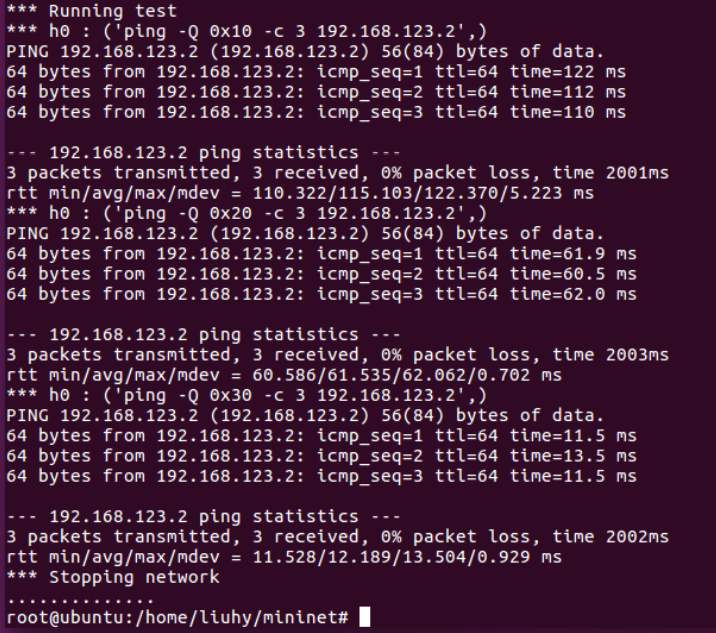
实验结论
此实验并未连接控制器,只通过脚本在单个/多个交换机中下发静态流表实现主机间的通信。在给多个交换机下发流表时,通过ping操作测试验证主机间的连通性,并通过-Q参数设置不同的tos值验证主机间的连通性及到达目的地址的时间,通过验证发现,tos值设置越大,时间使用越少。因为TOS值不同,走的路径不同,时间自然不同。